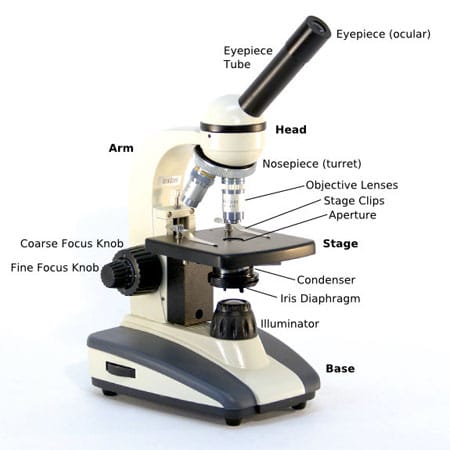Eyepiece Contains the ocular lens 10x Nosepiece Holds the objectives and can be rotated to change the magnification Objective Lenses. Below you will find the correct answer to Part of microscope to which objective lenses are attached Crossword Clue if you need more help finishing your crossword continue your navigation and try our.

Using A Microscope 101 Important Microscope Parts Functions
This light passes through the objective lens and into the persons eye through the eyepiece.

. It allows the movement of the tube upwards or downwards. Bright field microscope D. Supports the tube and connects it to the base of the microscope.
Ocular Lens Eyepiece - where you look through to see the image of your specimen. Yan po ang tamang sagkt. Objective lens system --- After light passes through the specimen it next enters this lens system.
Eyepiece Tube This is the part of a compound microscope that connects the eyepiece with the objective lens. The lens at the top of the microscope that you look through. Stereo microscope 19 Which part of the microscope are objective lenses attached.
Nosepiece - the rotating part of the microscope at the bottom of the body tube. It holds the objectives. The upper part of a compound microscope that holds the objective lens.
They eyepiece is usually 10x or 15x power. The bottom of the microscope used for support. Objective Lenses On most laboratory microscopes there are three or four objective lenses attached to the end of the eyepiece tube.
You should always store your microscope with this objective in place. The objectives are attached to what part of the microscope it can be rotated to click lenses into place Zacharias Janssen a Dutch spectacle manufacturer is credited with inventing the compound microscope in 1590 according to historians. These lenses tend to range from 4x to 100x magnifying powers but this will vary from microscope to microscope.
Turn the nose piece so that the low power objective is aligned with the object in the slide. Part of the microscope that can. Which of the following liquids can you use to make a wet mount.
Revolving Nosepiece or Turret. The answer to this crossword puzzle is 9 letters long and begins with N. Connects the eyepiece to the objective lenses.
Field of view --- Circular area seen through the eyepiece. When the coarse adjustment knob on the microscope is utilised a more unobstructed view of. High Medium and Low These are attached to the nosepiece and vary in size.
Ocular eyepiece It is a lens that is attached to a draw tube. Coarse adjustment knob It connects the arm to the base. Objective lenses you can see 3 - 4 objective lenses attached to the end of the tube.
It can be rotated to click the lenses into place Rotatingrevolving nosepiece. It helps incline the microscope for a more comfortable viewing. It can be manually rotated It can be manually rotated to select the objective lens that you wish to use.
Part of microscope to which objective lenses are attached Crossword Clue. The objective lenses are attached to this part. Inclination Joint It is a flat surface where the mounted slide is placed.
The nose-piece holds the objective lenses in a. The objectives are attached to what part of the microscope. The shortest lens is the least powerful and.
Also called a revolving nosepiece or turret. Transmission Electron microscope B. Eyepiece and body tube D.
What is the part of the microscope that holds the objective lens. The base and stage 18 Which of the following is not a type of light microscope. Phase contrast microscope C.
MAGNIFYING PARTS Objectives Metal cylinders attached below the nosepiece and contains especially ground and polished lenses LPO Low Power Objective Gives the lowest magnification usually 10x HPO High Power Objective Gives higher magnification usually 40x or 43x OIO Oil Immersion Objective Gives. Nosepiece --- Part to which the objective lenses are attached. Iris diaphragm --- Increases or decreases the light intensity.
You should always store your microscope with the objective in place. This is the part that holds two or more objective lenses and can be rotated to easily change power. The upper part of a compound microscope that holds the objective lens.
The upper part of a compound microscope that holds the objective lens. Usually you will find 3 or 4 objective lenses on a microscope. Body tube - the long tube that supports the eyepiece and connects it to the objectives.
Magnifies the specimen 10X actual size. Arm and base C. The objectives are attached to what part of the microscope it can be rotated to click the lenses into place.
Nosepiece Microscope part to which objectives are attached Nosepiece Rotated to allow for the changing of objectives to increase or decrease magnification Arm Microscope part to which the nosepiece is attached Arm A secure microscope part to grasp when the microscope is being carried scanning objective lens 4X Intermediate objective lens 10X. Hope it can help you. Which part of the microscope are objective lenses attached.
Also called a revolving nosepiece or turret. The objective lens is directly above the stage and provides the primary magnification. Eyepiece ocular --- Contains a lens at the top of the body tube.
A microscope has an ocular objective of 10x and a high power objective of 50x.

The Microscope 6th Grade Science Ppt Video Online Download


0 Comments